

| Flight Box Safety |
How
would you feel if you lost all your models,
your car and garage, maybe even your home?
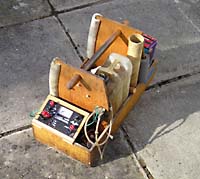 Sorry
to start this article with a shock horror first line, but this is a safety
issue which affects probably all of us. We all have them in one form or
another and they all have one thing in common. They are all potentially
dangerous. Each one contains a significant quantity of fuel, and a source
of ignition, i.e. the electrical system. For those who work with electricity,
most of this will be obvious. For those who don't, it may not be, and
hopefully there will be some useful stuff for them here.
Sorry
to start this article with a shock horror first line, but this is a safety
issue which affects probably all of us. We all have them in one form or
another and they all have one thing in common. They are all potentially
dangerous. Each one contains a significant quantity of fuel, and a source
of ignition, i.e. the electrical system. For those who work with electricity,
most of this will be obvious. For those who don't, it may not be, and
hopefully there will be some useful stuff for them here.
Let us think about a typical flightbox setup for a minute. Typically, you will have some form of container. This will have a fuel reservoir with a pump (electric or hand), a battery, a power panel and probably some storage space for tools.
The
Box
Most are made of either wood or plastic. Not really a lot to choose between
them, but my preference would be wood. A thought on the construction of
the box - it is much safer if you can separate the electrical part from
the fuel container. Some of the commercially available ones are built
this way. When you install all the equipment into the box it may seem
neater to hide all the wiring, fuel lines etc, but if something does go
wrong it will be obvious quicker if they are 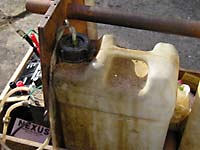 visible.
Make sure that there is somewhere for leaking or spilt fuel to drain away.
visible.
Make sure that there is somewhere for leaking or spilt fuel to drain away.
The
Fuel Container
Flightboxes are generally designed to take the 5 litre plastic containers
in which fuel is sold. These are obviously suitable for the purpose, but
would think about fitting a 2.5 ltr container instead. They are lighter
and if the worst happened, it would be a little easier to deal with. Check
their condition regularly, and if there is any sign of damage, replace
them. Make sure they are secured in such a way that they can be quickly
removed if necessary.
Batteries
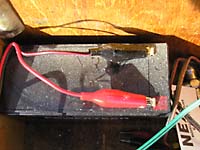 If you are going to use an electric starter, especially with larger engines then you should use at least a small motorcycle battery. A lot of model flyers use 7Ah gel cells, but these are not ideal. They are not designed high current applications. The connections on them are rated at 17.5A. To put that in context, my OS40FP blew 25A fuses on a cold day. Batteries capable of starting engines represent a fairly large amount of energy, and if shorted out, could burst and/or start a wiring fire. There should be a fuse in the wiring as near to the live terminal of the battery as possible.
If you are going to use an electric starter, especially with larger engines then you should use at least a small motorcycle battery. A lot of model flyers use 7Ah gel cells, but these are not ideal. They are not designed high current applications. The connections on them are rated at 17.5A. To put that in context, my OS40FP blew 25A fuses on a cold day. Batteries capable of starting engines represent a fairly large amount of energy, and if shorted out, could burst and/or start a wiring fire. There should be a fuse in the wiring as near to the live terminal of the battery as possible.
Connections to the battery and wiring from it to the power panel are crucial to safety - they must not short to each other, or work loose which would cause them to heat, and should be up to the current they are going to carry.
If you must use gel cells, they should be connected using proper flat spade connectors, although these do work loose if repeatedly connected and disconnected. Smaller starters may be connected to the power panel with the 4mm plugs. Larger ones are best connected directly to a car battery using the crocodile clips they are usually supplied with. The wiring in your box must be thick enough to carry the current. As a rough guideline, they should be as thick as, or slightly thicker than the wiring on your starter. Make sure any joints in the wire are either soldered or crimped properly.
Electric motors draw most current when they are stopped while switched on. If your starter stalls, or your fuel pump seizes, turn it off quickly and sort the problem before trying again. If anything stops working, isolate the power and find out why.
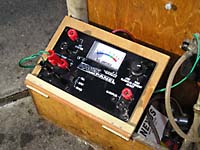 Glowstarts
Glowstarts
Glowstarts can also cause problems. They are supplies with plastic covers.
Make sure these covers are put back on when the glowstart is not in use.
If you don't, it may short out against metal objects in your box or your
pocket (nasty!).
Power
Panels
There are a wide variety of power panels on the market - some good, some
not quite as good. The two main problems they suffer from are not having
any covering on the back, and built in fuel pumps. Uncovered electrics
are vulnerable to being shorted out by metal objects.
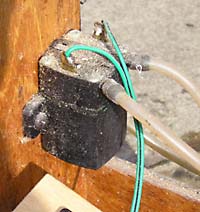 Built
in fuel pumps have two problems associated with them. Firstly
as we all know, these pumps are not very reliable, and tend to leak. If
they are mounted behind a power panel, they may unknown to you be filling
up your flight box, which is obviously dangerous. It is much better to
have the fuel pump mounted externally where you can see what it's up to.
Built
in fuel pumps have two problems associated with them. Firstly
as we all know, these pumps are not very reliable, and tend to leak. If
they are mounted behind a power panel, they may unknown to you be filling
up your flight box, which is obviously dangerous. It is much better to
have the fuel pump mounted externally where you can see what it's up to.
Second problem is the attachment of fuel lines. These are usually simple push-fit, and can blow off while the pump is running.
Power
panels are something that will stay with you, so it is worth spending
a little extra on good quality.
In Summary
A few thoughts on the day to day usage of your flight box:-
- Make sure the equipment you use is up to the job.
- Before you use it give it a once over as you would your planes. Check it's general condition with particular attention to wiring, connections and fuel lines.
- Connect the battery just before you start using it and disconnect it after you have finished.
- When transporting batteries, cover the terminals so they cannot be shorted out.
- When transporting fuel, do so in sealed containers, so it cannot spill.
- If you are unlucky enough to suffer a flight box fire, remember that you are more important than your models.
- Priority should be given to making others aware.
- If it is a small fire (bubbling or smoking wiring), try to isolate the battery bearing in mind it will be hot (consider keeping a pair of pliers or cutters handy) and when methanol burns it has a virtually invisible flame.
- Make sure a fire extinguisher is available.
- Tackle the fire only if you are sure it is safe to do so.
If you are in any doubt, ask one of the one of the electrical boffins in the club, or IM me in at the Forum.
Oggy
Photos by
Peter Dennis